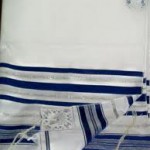Women wearing tallit & tefillin – Ask the Rabbi
Q. Is it permitted for women to wear tallit and t’fillin?
 A. There is a principle that in general women are exempt from time-bound positive commandments (“thou shalts”), but there are a number of exceptions.
A. There is a principle that in general women are exempt from time-bound positive commandments (“thou shalts”), but there are a number of exceptions.
Time-bound positive commandments which are intrinsically linked to negative commands, such as Kiddush on Shabbat, which is linked to the prohibition of work on Shabbat, are obligatory on women.
Time-bound positive commands which celebrate events in which the whole community was involved, such as hearing the M’gillah on Purim, are likewise obligatory on women.
There are also commands which women have chosen to observe out of piety, such as hearing the shofar.
May they opt to observe the mitzvot of tzitzit and t’fillin? (I know your question mentions the tallit which is worn during prayer, but the crucial element of the tallit is the fringes – tzitzit – which are worn on four-cornered garments throughout the day).
The “time-bound commandments” issue is still the major consideration.
Let us first look at tzitzit:
• The Aruch HaShulchan (Orach Chayyim 17) makes a distinction between tzitzit and the other time-bound commandments of shofar and lulav. The latter are limited to a few minutes of the year whilst tzitzit is carried out daily.
• Men created a four-cornered garment which is worn constantly so as not to limit the mitzvah of tzitzit to the tallit.
• Rav Moshe Feinstein allows women to have tzitzit on any four-cornered garment, so long as they do so out of genuine piety and not in order to make a statement. To avoid the problem of women wearing a men’s garment, Rav Feinstein speaks of women not putting tzitzit on exactly the same type of garment as that which men wear.
The second part of the question deals with t’fillin.
Rabbinic authorities do not permit them to women. T’fillin go directly on the body and there is a problem of bodily cleanliness at certain times; women have a different bodily regime than men.
But as men too cannot guarantee bodily cleanliness, they usually keep the t’fillin on for a limited time (during morning prayers) and not all day, though some exceptionally pious men do wear t’fillin for extended periods.
The Talmud (Eruv. 96a) says that King Saul’s daughter Michal wore t’fillin and the sages did not object, but she was an exception and we do not derive anything from her example.



